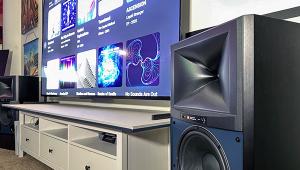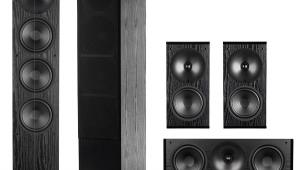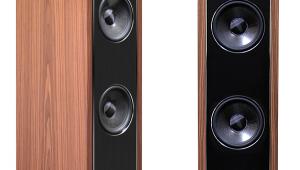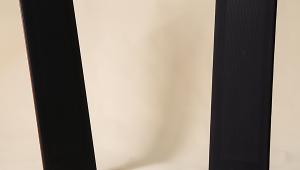PSB Imagine T3 Speaker System Review Page 2
The relocation put the speakers further out into the room—nearly 6 feet from baffle to wall—than I probably would want to live with permanently (in a larger room, this would be no problem), but the effect was transformative. There was still plenty of second-octave bass to spare, but the excessive richness on elements such as pop bass guitar, low-voiced announcers, and soundtrack rumbles was gone, and this one adjustment revealed the T3 as, effectively, a near-perfect full-range reproducer.
Midrange balance was ideal: open, detailed, and utterly coloration-free on every voice or instrument, such that dense stereo music like a 96/24 FLAC of “Vast Continent” from the Yoichi Murata Orchestra could effortlessly breathe and reveal all the strands of its elaborate big-band arrangement, as well as the full depth of this excellent recording’s considerable soundstage. And high-treble tests like brushed cymbals and brass transients evidenced the sharply etched but non-tizzy, un-harsh definition that I only hear from expensive tweeters deployed by designers with a thorough understanding of tweeter/midrange/cabinet-surface interactions. (The T3’s unusual “tweeter-under” configuration places the tweeter below the midrange transducer, which helps locate the in-phase lobe of the combined response at seated ear-height, among other factors.) There are few better sources for experiencing this than a rock drum kit well played and well recorded, of which you’ll find few better examples than those on the classic Sheffield Drum Record. My trusty CD copy did its usual duty, and the PSBs reproduced Ron Tutt’s and Jim Keltner’s extended, unadorned solos to pretty damned convincing effect. Nothing, nothing, will fully reproduce the truth of standing next to live trap drums played hard, but the Imagine towers came excitingly close.
Surrounded Again
Moving on to multichannel playback with a 5.0 setup (still no subwoofer), I found that the Imagine C3 speaker, reasonably compact for a three-way center, is an immensely capable speaker in its own right, giving up little if anything to the T3 in terms of authenticity or dynamics. Better still, at least in my system, its tonal match to the towers was superb, as demonstrated by comparisons of various announcer voices between mono (center) and stereo (towers) reproduction. In fact, it was the best match I’ve heard from any center with a horizontal woofer layout. I’d posit that the C3’s designers took into account the fact that a large, acoustically reflective surface—i.e., a television screen—is likely to be located directly adjacent to it.
The full PSB array cheerfully absorbed all available 150 watts per channel of my power amp with no hint of distress in any channel. These are fairly sensitive speakers, so this was ample power in my room; my amp reached well beyond any rationally desirable loudness long before reaching gross clipping. Even in a somewhat bigger room, this power level should be fully adequate.
Match all this up with the Imagine S surrounds, and you have a reference-class system for film-sound reproduction. With the surrounds wired in my preferred dipole mode, the bubble of ambience from front to rear was very nearly seamless, such that material like the cave scenes in The Hobbit: The Desolation of Smaug on Blu-ray conjured a very convincing ambient space, while the full system’s impressively clean dynamic abilities maximized the wow factor in the film’s countless big-action scenes.
Many listeners of multichannel music prefer direct-radiator (monopole) or bipole surrounds for hard-panned multichannel productions, but most of my listening consists of orchestral and chamber recordings that retain the front-stage image, relying on the surrounds for hall-sound ambience. In such cases, I consider dipoles perfectly workable and perhaps even preferable, though bipoles work nearly as well and are clearly superior for the other kind of discrete-locations surround music—The Dark Side of the Moon on SACD, for example. Unfortunately, changing over the Imagine S’ connections from dipole to bipole was a chore, especially for speakers wall-mounted head-high. So after due diligence in experimenting, I simply left them as dipoles, without a qualm. That said, an accessible bipole/dipole switch would’ve been awfully nice.
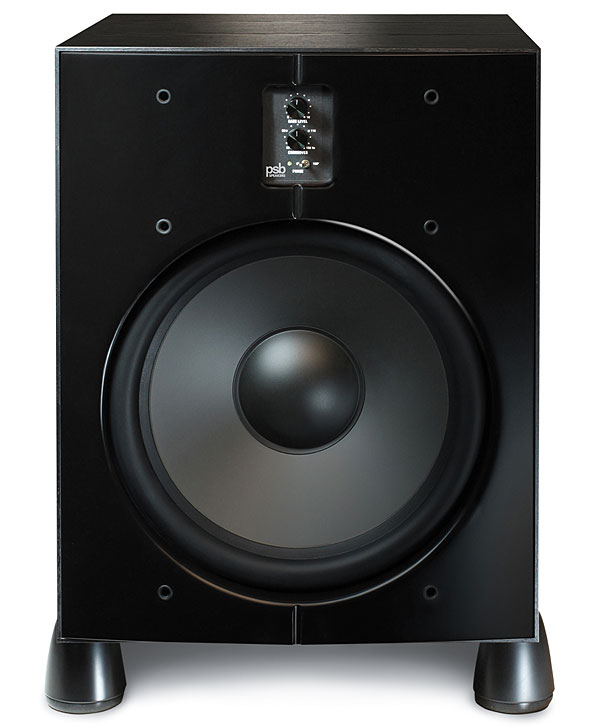
Now to that subwoofer. The SubSeries 300 is a very capable woofer, with substantial output to 25 Hz in my room (and even a bit lower) and tight, controlled second-octave contributions. When I rebalanced the system to integrate the sub with a 60-Hz crossover point and carefully matched level and phase, the differences in bass smoothness and bottom-octaves spatial and temporal integrity, relative to the 5.0 system, were essentially nil. But that begs the question: Do you really need the sub in an Imagine T3 system? For my tastes (which rarely if ever demand cinema reference level and runs to a leaner/tighter bottom-octaves balance) and for my room (which is just under 3,000 cubic feet), not so much.
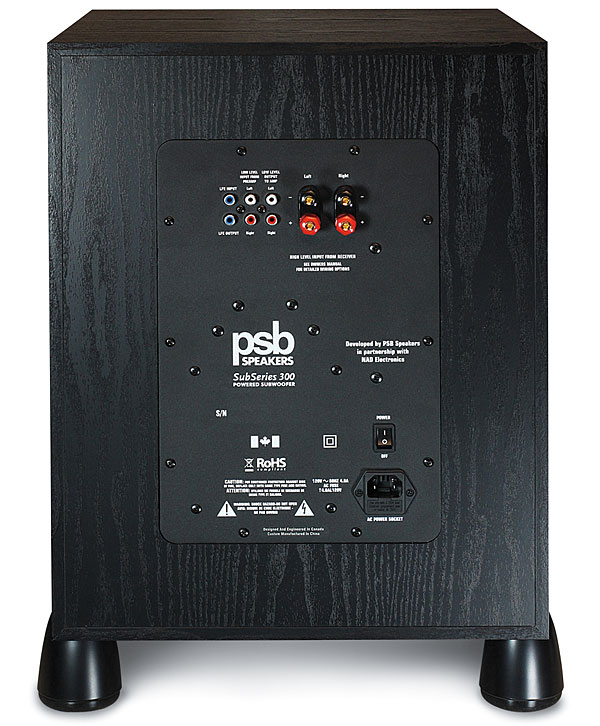
In a larger room, or for a listener who regularly wants to rock the house with truly big-cinema levels, maybe. The addition of the sub does remove demanding low frequencies from the towers and their associated amplifiers, after all. The T3s alone, in my room at least, had no difficulty with 25-Hz material, nor with top-grade cinema-sound low end, and the sub itself didn’t seem to go a great deal lower, if at all. My ultimate configuration was to run the T3s full range and cross the C3 center and S surrounds over (to the towers) at 60 Hz, with the SubSeries 300 performing as a supplementary LFE-only reproducer. Deployed thus, the subwoofer contributed— relatively rarely—an extra few decibels on big-budget effects like explosions or ultra-low rumbles or synth-bass thriller cues. For music in surround, I was perfectly happy with the wooferless 5.0 setup, which I retained in a processor preset. Of course, every room is different, as is every taste, but you could certainly add this or another sub at a later date without sacrificing much in the way of performance.
Conclusion
Is PSB’s Imagine T3 system otherwise perfect? Of course not—though frankly, I’m straining to find shortcomings, other than the cost. Even for a full-sized 5.1 setup, the Canadian suite is far from cheap. But then again, for what it delivers—reference-class performance in every parameter—the PSB suite is, if not a downright bargain in today’s high end, a very fairly priced offering.




